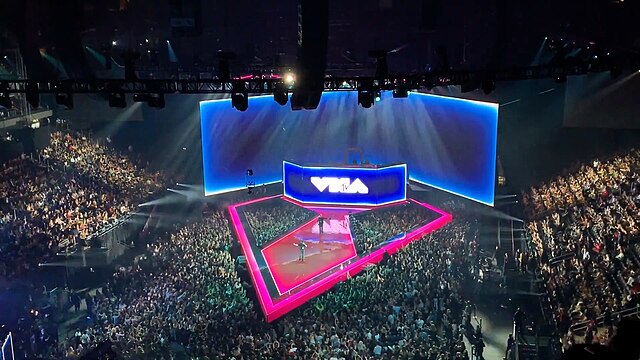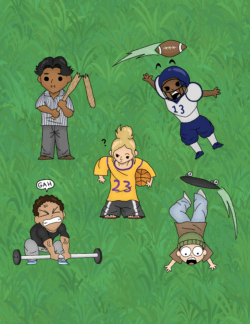Since the now-nostalgic days of Music Television (MTV), the music video scene is flooded with creativity, controversy, and the promise of a good time. After MTV’s first music video, “Video Killed the Radio Star,” people flocked to their TV screens each day to see their favorite artists’ visual interpretation of hit songs, entering a world where lyrics become reality and musical notes are accentuated by the occasional dance break to create even more visual excitement.
Just three years after the founding of MTV, the Video Music Awards (VMAs) emerged as an ode to the popularity of this new form of content and as a video-focused alternative to the Grammys. The show’s first airing encompassed the star power that now defines it, with celebrities such as Cyndi Lauper, Billy Idol, and Cher in attendance.
Although the VMAs are still around, MTV seems a fad of the past, flooded with reality TV shows rather than the music that gave the channel its name. In fact, the VMAs seem to be MTV’s last pillar of success before the channel fizzles out for good. This downfall may seem completely natural, as all things—even those as monumental as MTV—have an expiration date, but it does lead one to wonder: when will the VMAs truly expire, and have music videos themselves become a dying art form?
The 2025 VMAs, which took place on September 7, 2025, offered plenty of iconic, buzz-worthy moments for viewers to obsess over. From Lady Gaga’s show-stealing wins to the tribute to rock legend Ozzy Osbourne, fan-favorite moments were quickly clipped and posted online, with people singing their praises for the show as a whole. I mean, who doesn’t want to watch Sabrina Carpenter’s dance break in “Tears” (2025) over and over again? The 2025 VMAs received a near 42% viewership increase from last year, and it seems like the fans like what they see. So, why would one choose to “pray on the downfall” of this successful award show? Well, while I am a fan of the VMAs, I am also one of the many who ponder the award show’s fate, especially in light of recent changes in our society.
In 1984, the VMAs officially launched with iconic performances from stars like Madonna and Tina Turner, immediately cementing itself into youth culture. Even now, every time the infamous award show rolls around, it can’t seem to stay out of the headlines. It has since offered several well-known and iconic moments in pop culture, from Kanye West interrupting Taylor Swift’s Best Female Video acceptance speech to Lady Gaga’s meat dress. Yet, like MTV itself, every seemingly unstoppable force in the entertainment industry has a competitor that changes everything. Cable TV had Netflix, CDs had Spotify, and MTV had YouTube.
In the early 2000s, just when MTV chose to diverge from being a completely media-driven platform, YouTube entered the scene. Since MTV now appeared overcrowded by reruns and reality shows, many artists saw the easy-upload style of YouTube and pivoted. This, in turn, allowed YouTube to grow into the top music video streaming platform, a title it has retained since. In fact, a vast majority of the music videos and artists seen at the VMAs are now on YouTube, gaining millions of views.
Recently, another notable competitor has entered the scene: social media. The infamously toxic yet highly addictive short-form content has taken over our phones and our minds. Whether from looking at TikTok trends or scrolling endlessly through Instagram, our minds have grown used to more content in shorter periods of time. We’d rather sit through a 10-second video than a 10-minute one—we’re getting entertainment either way, and one takes up much less of our precious time—and artists have caught on. You’ve probably run into some of your favorite artists, along with up-and-coming ones, advertising all over the platforms you browse every day. This is even how many now well-known artists, such as Chappell Roan and Benson Boone, have “blown up” in the past few years.
Social media has become the new marketing technique for many artists, who’ve realized that more videos in a shorter time means more opportunities for exposure. Indeed, this can be beneficial for artists trying to go viral, but it can also harm what we already have in the music industry. A majority of music videos range from 2-6 minutes of content, largely differing from the norm we’ve grown accustomed to. This longer content may be okay for us to handle now, but what about in a few years? When will the addiction to social media completely consume our attention span?
Success is fragile; what is popular one second can be completely out of the public view the next. While music videos may seem to have a steady viewership now, this fame may all collapse in an instant. However, while these video art forms may disappear in time, one thing will stay constant: the music. Whether through artistic interpretation using a camera, live on a stage, or through headphones on a Spotify playlist, music will always be there with us as we cry, smile, scream, and grow older. The music video itself isn’t important, but rather a creative way to express the tunes we all love in a new, innovative way. It helps convey the artist’ true emotions, and provides new content for fans. Artists like Conan Gray, with his three-part music video trilogy for his new album Wishbone, continue to prove that we still have stories to tell with these videos, and the platform for long-form videos has not died yet.
Music videos may be doomed, but so are many of the things we see now in the media. Cable TV, Vine, and MTV are only a few examples of media platforms that have slowly fizzled away. However, there may be a chance for revival. For instance, a renewed interest in vinyl records and retro CDs proves that even what has been left behind can make a return. Maybe the same is bound to occur for music videos: the market for all things “retro” grows by the day, and who’s to say music videos can’t become a part of that category?
Whether it is sitting down to watch the VMAs today or looking towards its future, this award show’s constant stream of risk-taking ideas, innovative thinking, and creativity has defined its legacy. Its ability to capitalize on “viral culture” has launched a new form of artistry with the music video and cemented singers and songwriters as popular personas rather than just voices in our headphones. Our new need for short-form content will surely kill many parts of the entertainment industry, including music videos, but I hope this death does not come anytime soon. Music videos are a unique creative outlet for both musician and listener, so while we all still can, let us enjoy the art made by the singers and songwriters we love.





